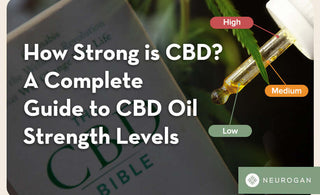CBD oil strength refers to the amount of cannabidiol (CBD) present in a product, typically measured in milligrams (mg). This is often displayed as the total amount of CBD in the entire bottle, but what's more useful is understanding how much CBD is in each dose.
If a CBD product is labelled as 5%, it means 5% of the bottle’s total contents are CBD, and the remaining 95% is made up of other ingredients and the carrier oil. For a 15 ml bottle, this equates to 0.75 ml of CBD, which is equivalent to 750 mg of CBD.
CBD Oil Strength Explained
To calculate the actual CBD strength per serving, divide the total CBD content by the volume of the bottle. For example:
| CBD Concentration Guide | ||
|---|---|---|
| Total CBD (mg) | Bottle Size (ml) | CBD per ml (approx.) |
| 300MG | 30ml | 10MG/ml |
| 600MG | 30ml | 20MG/ml |
| 1000MG | 30ml | 33.3MG/ml |
| 1500MG | 30ml | 50MG/ml |
| 3000MG | 30ml | 100MG/ml |
CBD oil strengths fall into three categories based on their concentration: low, medium, or high. Here, strength tells you how much CBD is in the bottle, not how much to take or how it will affect you. Once you understand CBD strength and know the effects you’re looking for, you can adjust your dosage to find what works for you.
| CBD Concentration Levels | ||||
|---|---|---|---|---|
| Concentration Level | Total CBD (per 30ml bottle) | CBD per ml | Typical Users | Purpose/Use |
| Low | 100–500MG | ~3–26MG | Beginners or those seeking mild effects | Gentle introduction to CBD for mild support |
| Medium | 600–1000MG | ~20–33MG | Users with some experience | Support for relaxation or better sleep |
| High | 1500–3000MG | ~50–100MG | Experienced users wanting strong effects with less volume | Consistent high intake of potent formulations |
There are stronger options of CBD per ml available, such as our High Potency CBD Oil in 12,000MG per bottle.
How to Calculate the Strength of Your CBD Oil
Calculating the strength of your CBD oil is straightforward and essential for informed use. The formula is simple: divide the total amount of CBD (in MG) by the volume of the bottle (in ml).
For example, if a bottle contains 1000 mg of CBD in a 30 ml container, it provides approximately 33.3 mg per ml. If you take half a dropper, or 0.5 ml, you’re getting just over 16 mg of CBD.
For people who have never used CBD products, 10 mg is commonly seen as a light dose, while 50 mg may be better suited to those with more experience or specific preferences.
Factors That Affect CBD Strength and Efficacy
Even when you understand the numbers behind CBD strength, many personal and product-related factors may influence how CBD is experienced. Body weight and metabolism can impact how quickly and effectively CBD is absorbed and processed [4]. The method of delivery also plays a role; sublingual oils, capsules, gummies, and vaping each offer different absorption rates and durations.
Another variable is the consistency of use. Some users report that taking CBD regularly over time produces more noticeable effects than using it sporadically [1]. Everyone’s body chemistry is unique, which means the same dose may feel different from one person to another [2]. This makes experimentation and personalization an important part of using CBD effectively.
How to Choose the Right Strength for You
Deciding what is a good CBD strength depends largely on your goals, your prior experience with CBD, and how your body responds to cannabinoids. Beginners are generally advised to start with a low-strength oil, such as a 300 mg bottle, and take a small daily amount, often in the range of 10 to 20 mg.
If, after a few days or weeks, you notice little to no effect, you might consider increasing your dose. But it’s best to do it slowly. Switching to a medium-strength oil may allow you to take fewer droppers per day while maintaining the same overall intake. Experienced users often transition to higher-concentration oils as a way to simplify their dosing routine.
To put it in context: Is 10MG of CBD a lot? For many, it’s a starting dose. On the other hand, is 50MG of CBD a lot? That depends. For a new user, it might feel like a substantial amount, while someone with more tolerance may find it to be moderate.
Misconceptions About CBD Strength
There are a few misconceptions surrounding CBD oil strengths. One of the most common is the idea that more CBD automatically equates to better effects [3]. This isn’t always the case, as some people may respond well to low or moderate doses, and increasing the amount might not lead to improved outcomes.
Another area of confusion comes from product labels. Some labels emphasize the total milligrams of CBD in the bottle but fail to indicate how much is in each serving. Purity and strength are sometimes combined, as well. While a product might be made with extremely refined CBD, that doesn’t necessarily mean it delivers a large amount per dose.
To avoid confusion, it’s best to focus on the actual CBD content per milliliter and verify that information against third-party lab results.
Reading CBD Product Labels Accurately
To find a strength that is best for you from the wide range of CBD products available, being able to read and understand a product label is essential. Start by identifying the total CBD content in milligrams, checking the size of the bottle to determine the concentration, and paying attention to the serving size.
It’s also important to understand what type of CBD is used in the product. Full-spectrum oils contain a range of cannabinoids, including trace amounts of THC, while broad-spectrum products have THC removed. Isolate oils contain only CBD. You should also look for third-party lab test results, which confirm the contents and purity of the product.
Finally, if you’re concerned about legality or drug testing, reviewing the THC content is vital. Even small amounts of THC can be relevant depending on your circumstances.
Finding the Right CBD Strength is Personal
Selecting the appropriate CBD oil strength isn’t about choosing the product with the largest number on the label. Instead, it’s about aligning your choice with your experience level, body chemistry, and desired outcome. Whether you’re wondering how strong CBD is or considering whether a 3000MG bottle fits your needs, it helps to approach your decision thoughtfully and gradually, by starting on a low dose and increasing it slowly over time.
CBD strength comparisons are a useful tool when making decisions, but ultimately, how much CBD to use depends entirely on you, and finding that balance is part of the process.
Still not sure what you need, or which CBD product to start with? Take our Personalized CBD Finder Quiz.
Sources:
-
Kaufmann, R., Harris Bozer, A., Jotte, A. K., & Aqua, K. (2023). Long-term, self-dosing CBD users: Indications, dosage, and self-perceptions on general health/symptoms and drug use. Medical Cannabis and Cannabinoids, 6(1), 77-88.
-
Moazen-Zadeh, E., Chisholm, A., Bachi, K., & Hurd, Y. L. (2024). Pharmacokinetics of cannabidiol: a systematic review and meta-regression analysis. Cannabis and Cannabinoid Research, 9(4), 939-966.
-
Kolli, A. R., & Hoeng, J. (2025). Cannabidiol bioavailability is nonmonotonic with a long terminal elimination half-life: a pharmacokinetic modeling-based analysis. Cannabis and Cannabinoid Research, 10(1), 81-91.
-
Williams, N. N. B., Ewell, T. R., Abbotts, K. S. S., Harms, K. J., Woelfel, K. A., Dooley, G. P., ... & Bell, C. (2021). Comparison of five oral cannabidiol preparations in adult humans: pharmacokinetics, body composition, and heart rate variability. Pharmaceuticals, 14(1), 35.



